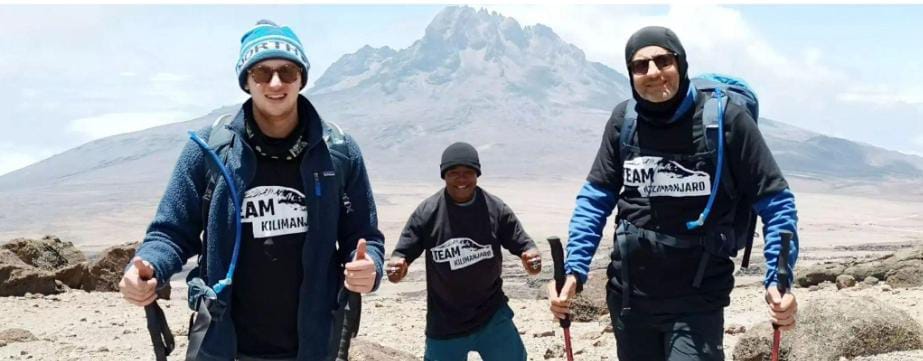In an age where so much feels uncertain — from global politics to personal purpose — more people are seeking experiences that mean something. They want less distraction and more discovery; fewer screens and more sky.
That might explain why Mount Kilimanjaro, rising 5,895 metres above the Tanzanian plains, has become one of the most powerful symbols of renewal in the modern world.
To climb Kilimanjaro is to step away from the noise and into perspective. It’s not a technical climb; it’s an emotional reset — a test of patience, preparation, and presence.
And in that way, it mirrors the moment we’re living in: a global desire to trade busyness for balance, and achievement for authenticity.
A Universal Challenge
Kilimanjaro stands apart from other famous peaks. You don’t need ropes or mountaineering skills — only fitness, focus, and humility. It’s accessible to anyone willing to work for it, yet humbling enough to command respect.
Each year, tens of thousands of climbers — CEOs, teachers, students, retirees — take on the challenge. The route they walk is the same: forest to moorland to desert to ice. But the journey they experience is personal — a process of peeling back comfort until only determination remains.
In an era defined by speed, Kilimanjaro demands slowness. Progress happens pole pole — “slowly, slowly,” as Tanzanian guides say. It’s a mantra that resonates far beyond the mountain.
How Long Does It Take?
The most common question — how long does it take to climb Kilimanjaro? — is also the most revealing. Technically, it can be done in five days. But to climb it well, to allow the body to adapt and the mind to settle, takes seven to nine.
That slower pace isn’t just safer; it’s saner. It’s a deliberate rhythm that forces you to let go of urgency — and in the process, rediscover patience.
The Smarter Route
There are several paths to the top, each with its own story. The traditional Machame and Umbwe routes are dramatic but crowded, with steep sections that waste energy — including a 401-metre ascent lost almost immediately into Karanga Valley.
Team Kilimanjaro’s TK Lemosho Route has earned a reputation as the most strategic and satisfying. It’s longer, quieter, and better designed for acclimatisation. The trail winds gradually from the west, through untouched forest and high plateaus, before curving north toward the summit.
For those who want an even rarer experience, the Excel Extension allows a night inside the crater at 5,729 metres — sleeping above the clouds, surrounded by ice and starlight.

The Right Season for the Right Mindset
The best time to climb Kilimanjaro depends on what kind of experience you’re seeking.
The dry months — January to March and June to October — offer clear skies, firm trails, and near-perfect conditions. These are the months for those who want focus, clarity, and calm.
But for climbers who crave introspection, the quieter rainy seasons (April–May and November) offer solitude. The mist hangs low, the forest breathes, and the mountain feels like a secret. It’s harder — but also more human.
Support, Structure, and Sustainability
Every Kilimanjaro climb is supported by a team — guides, porters, and cooks who form the heartbeat of the expedition. Tanzanian regulations require their presence, but their role extends beyond logistics: they set the pace, ensure safety, and teach resilience through grace.
Team Kilimanjaro operates with a model that combines ethical employment, environmental responsibility, and world-class organisation. Its seven “support series” reflect different climbing philosophies.
The Advantage Series, chosen by around 70 percent of climbers, offers comfort without compromise: three-course meals, private toilets, and professional service. The Superlite Series attracts independent adventurers who prefer simplicity and self-reliance. And at the top of the scale, the Hemingway Series provides elegance at altitude — fine dining, private staff, and a pace that feels timeless.
Each series reflects a truth about modern exploration: luxury isn’t about excess; it’s about intention.

The Summit as Symbol
Summit night begins at midnight. The air is thin, the cold sharp. Headlamps trace a slow zigzag of light up the dark slope. Breath becomes music, footsteps become rhythm.
After hours of focus, the sky brightens. The glaciers glow rose and gold. And then — the sign at Uhuru Peak, 5,895 metres. Uhuru means “freedom” in Swahili, and that’s what it feels like: release, renewal, and clarity all at once.
It’s not about ego. It’s about perspective. The climb strips life down to essentials — and when you finally look out from the top of Africa, you see how simple real success can be.
The Descent to Clarity
As climbers descend, the air thickens and colour returns — the greens of the rainforest, the warmth of soil and light. Conversations come back. Laughter returns.
Many extend the journey with a safari through the Serengeti or a few tranquil days on Zanzibar’s beaches. But even those who head straight home carry something rare: a calm, focused energy that endures long after the climb is done.
The Global Meaning of the Mountain
Kilimanjaro has always symbolised endurance, but in recent years it has taken on a new meaning. It’s a beacon for the post-digital generation — people seeking connection, community, and authenticity in a world that too often feels synthetic.
It’s also a model for sustainable tourism done right. By providing fair wages, using fresh local produce, and minimising waste, operators like Team Kilimanjaro demonstrate how travel can empower rather than exploit.
To Kilimanjaro veterans, the mountain’s message is both ancient and urgent: patience, respect, and purpose are the real currencies of achievement.
Why It Matters Now
We live in an age obsessed with acceleration — faster results, faster gratification, faster everything. Kilimanjaro slows you down until you remember what it means to earn something.
It’s a reminder that the path to clarity — whether personal, professional, or spiritual — is rarely instant. It’s built step by step, with humility and heart.
And perhaps that’s why, amid all our noise and novelty, the world’s attention keeps returning to this silent giant in the clouds: a place where endurance still matters, beauty still humbles, and freedom still feels like something worth climbing for.


